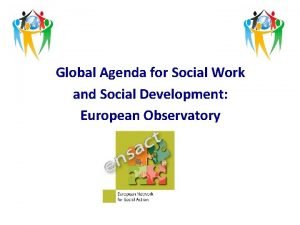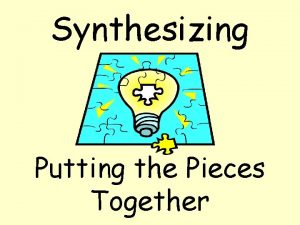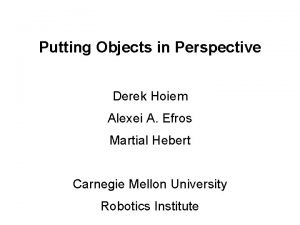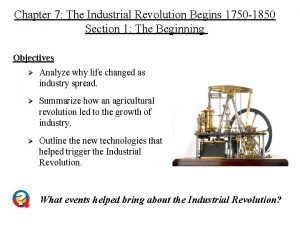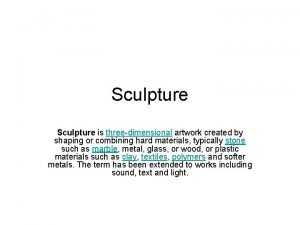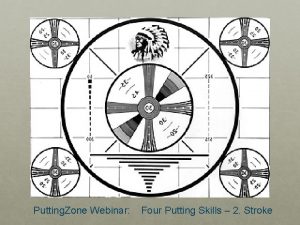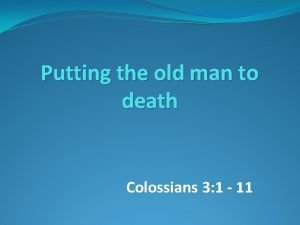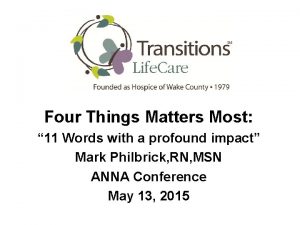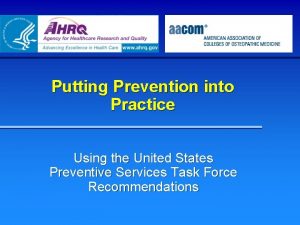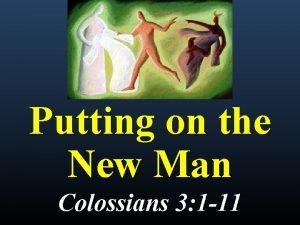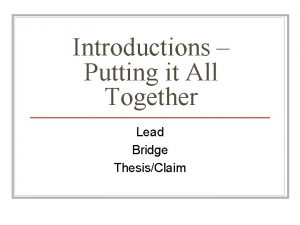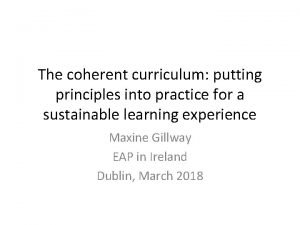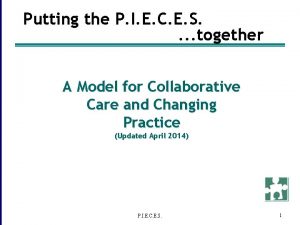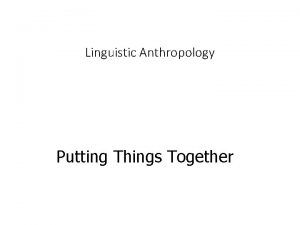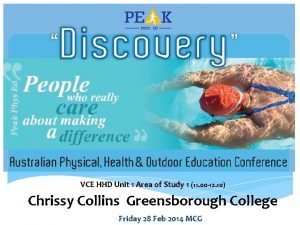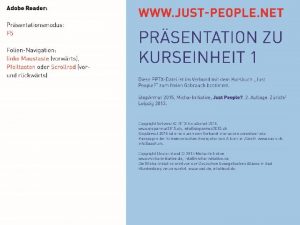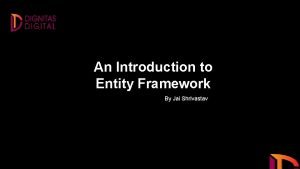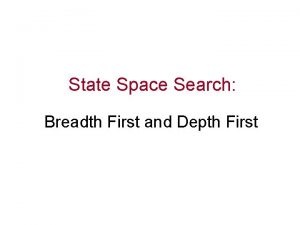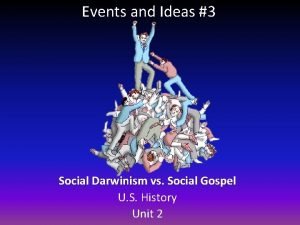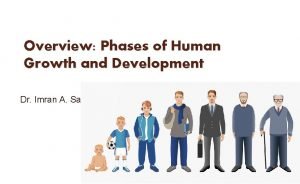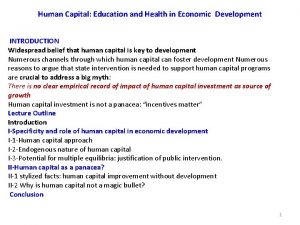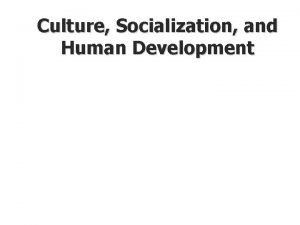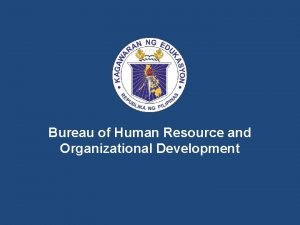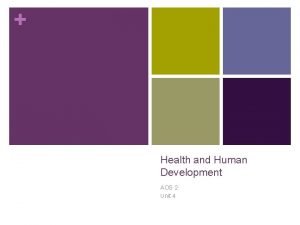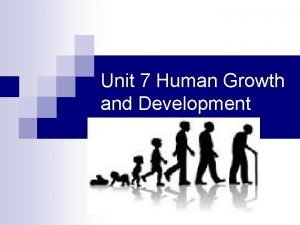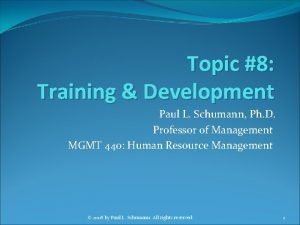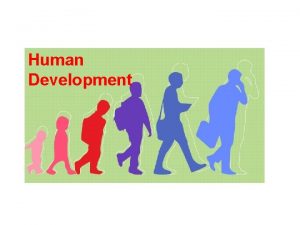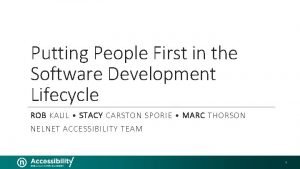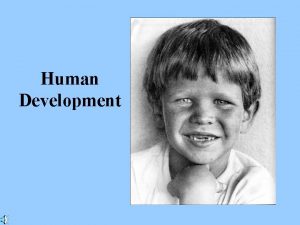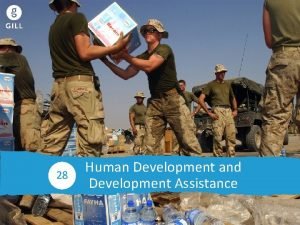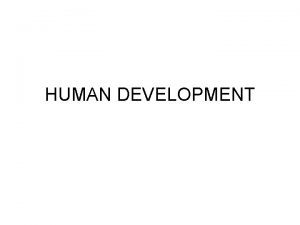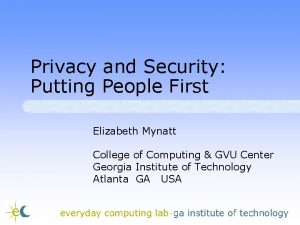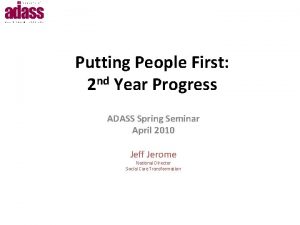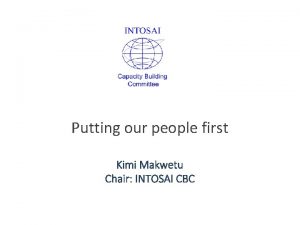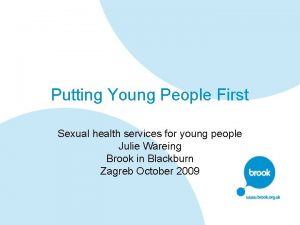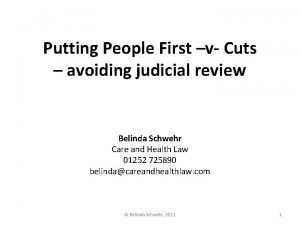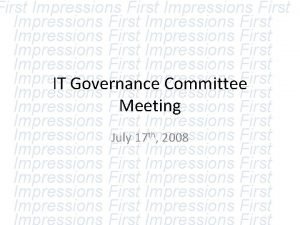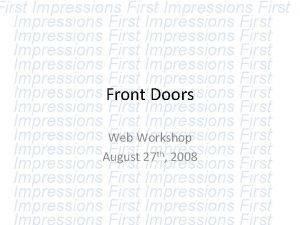Putting people first Human and social development as





























































- Slides: 61

Putting people first: Human and social development as if people mattered Board Voice Society of BC Conference and AGM 27 November 2014 Dr Trevor Hancock Professor and Senior Scholar School of Public Health and Social Policy University of Victoria

Outline What business are we in? 1. a) What really matters? The environments people inhabit 3. Creating Healthy Communities 2. a) Building community capital Implications for community governance 4. a) What we do b) How we do it c) How we monitor progress 5. Its more than a Social Policy Framework

1. What business are we in? What really matters? What are we trying to develop? �The economy? �People? ◦ Individually and collectively �The planet? Its bigger than a Social Policy Framework

Human-centred development �“People are the real wealth of nations. ” Human Development Report �“A Nations Health is a Nation’s Wealth” Masthead of The Sanitarian, a 19 th century public health journal �“It’s the people, stupid!” My response to Bill Clinton’s slogan – “It’s the economy, stupid”

“the human person is the central subject of development” Declaration on the Right to Development UN General Assembly, 1986

Human development �“is about creating an environment in which people can develop their full potential and lead productive, creative lives in accord with their needs and interests” Human Development Report http: //hdr. undp. org/en/humandev/

We need to ‘grow’ people. . . not the economy “Build me a garden to grow people in!” Jim Rouse, developer of Columbia MD

Human development for all �“Social injustice is killing people on a grand scale. ” WHO Commission on Social Determinants of Health, 2008 �“When inequality becomes too great, the idea of community becomes impossible. ” Attr. to Raymond Aron

2. The environments people inhabit are the environments we need to shape �Natural �Built �Social �Organisational Its bigger than a Social Policy Framework

The 80/90/100 rule � 80 ◦ We are 80% urbanised � 90 ◦ We spend 90% of our time indoors ◦ And 5% in vehicles ◦ = 1 hour (5%) outdoors (and mostly urban) � 100 ◦ We live 100% of the time within natural ecosystems

2 a) The ecological determinants of health �We have become so fixated on the social determinants of health that we have neglected the ecological determinants of health ◦ Population health has been ecologically blind 11

The ecological determinants of health We depend on ecosystems for the very stuff of life: �Air �Water �Food �Fuel and materials �Protection from UV radiation �Waste recycling and detoxification and �A relatively stable and livable climate. 12

Crossing Planetary Boundaries • • Genetic diversity = extinctions per million species-years (E/MSY) Functional diversity = Biodiversity Intactness Index (BII) Novel entities = POPs, heavy metals, nanoparticles etc Steffen et al, 2015 13

Ecological footprint, 1961 2010 Source: WWF Living Planet Report 2014 Summary (p 10) / 14

Living Planet Index 1970 - 2010 52% decline • the number of mammals, birds, reptiles, amphibians and fish across the globe is, on average, about half the size it was 40 years ago. Latin America shows the most dramatic decline – a fall of 83 per cent. Source: WWF Living Planet Report 2014 Summary (p 8) 15

Its more than climate change! Global ecological change includes �Climate and atmospheric change �Resource depletion �Pollution and ecotoxicity �Loss of species and biodiversity

Welcome to the Anthropocene! �Our efforts to subdue nature have been so successful that the time in which we now live has been called the Anthropocene - it will show up in the geologic record

2 b) Health and the built environment �This is where we spend almost all our time �So it is our most important environment

“We shape our buildings and afterward they shape us. ” Sir Winston Churchill

Build me a garden to grow people in Jim Rouse Developer of Columbia MD

2 c) The social environment Four aspects of social capital �Family �‘Informal’ - social cohesion and civicness (Putnam) �‘Formal’ - public investment in the social infrastructure (health services, education, social services, libraries etc) �‘Invisible’ - the judicial, political and constitutional infrastructure of society

2 d) The organisational environment �Schools, colleges, universities �Workplaces �Hospitals, other institutions �Governments ◦ Governance

An eco-social approach is needed Social change drives ecological change �Population growth �Economic growth �Growth in power and pervasiveness of technology BUT �Ecological change will drive social change – usually negatively

The IPAT Equation: Impact = Population x Affluence x Technology Societal & human forces driving change, 1900 – 2011 24

Impact over an 80 year lifespan � 1% annual growth in population = 2. 2 x � 3% annual growth in real GDP = 10. 6 x � TOTAL OVER 80 YEARS = >23 x Even if our technology became 5 times more efficient, it is still >4 x 25

3. Creating Healthy Communities

What determines the wellbeing of the population? �Its NOT primarily the health care system �Most of the major determinants of health lie beyond health care �So the most important policies for health lie outside the Ministry of Health �Local living and working conditions are very important

Access to health The health of the population is largely dependent on access to such major determinants of health as � Peace and a safe community � Clean air and water � Food � Shelter � Education � Adequate income � Social support � Sustainable resources and healthy ecosystems � Social justice & equity Based on the Ottawa Charter for Health Promotion – Prerequisites for health

Definition of a Healthy City “A healthy city is one that is continually creating and improving those physical and social environments and expanding those community resources which enable people to mutually support each other in performing all the functions of life and in developing to their maximum potential. ” Hancock & Duhl, 1986

30

Real capitalism Real capitalists do not build just one or two forms of capital – built and economic capital – by depleting the other three forms of capital. They build all five forms of capital simultaneously.

A new capitalism for the 21 st century The new capitalism must simultaneously increase ◦ ecological capital ◦ social capital ◦ economic capital ◦ built capital and ◦ human capital

4. Implications for community governance a) What we do b) How we do it c) How we monitor progress

The purpose of government - and governance The central purpose of any government and process of governance is – or should be – to maximise the health, well-being and quality of life of ALL the people ◦ within the limits of local, regional and global ecosystems

Governance - more than government �Governance is “the sum of the many ways individuals and institutions, public and private, plan and manage the common affairs of the city. ” (UN Habitat, 2002) ◦ involves individuals as well as institutions ◦ the private realm as well as the public realm

How can communities support human development? Recognise that a healthy, flourishing population is the community’s most important asset 2. Put sustainable development of human potential for all at the centre of local governance 3. Recognise this calls for a collective effort 1.

How does local government improve health? Public works Sanitation, clean water Housing Parks Education Transportation Police, fire Social services Public health Health services Shelter Recreation, nature Knowledge and skills Mobility, safety Support Protection, prevention Treatment and care

Why should local governments do it? Because �they are where most people live �they are the closest level of government to people �they are concerned with the quality of life of their citizens ◦ Not focused on GDP �they influence many of the determinants of health

Why they may do it best �Politicians and public servants live in the communities they serve ◦ Their decisions directly affect themselves, their families and friends ◦ They are connected into local networks ◦ They hear and engage in the local discussions �The policy-making apparatus is more intimate ◦ They are more likely to know each other

Municipal governments focus on people �Provincial and federal governments and the media are fixated on GDP and GDP growth �Municipal governments are not – they measure quality of life

How do we do it? This requires �A vision ◦ “Vision is values projected into the future” – Clem Bezold, Founder, Institute for Alternative Futures �A conceptual model �A set of mechanisms �New forms of governance

It begins with a dream, a vision


Some key principles of healthy (local) governance �Political commitment �Community engagement �Asset-based community development (ABCD) �Intersectoral action �Healthy public policy We need new forms of democratic governance for the 21 st century

A set of mechanisms and structures Political commitment � ◦ Led by the Mayor and Council ◦ Healthy public policy � ◦ � Community engagement Local participatory councils Intersectoral action ◦ Within City Hall, a technical group ◦ Beyond City Hall, a leadership group �Key structures ◦ Leadership ‘Council’ – civic leaders ◦ A Healthy City Office – technical support

New forms of governance �Belo Horizonte, Brazil, has a Municipal Deputy Secretary of Democratic Governance �Why doesn’t every municipality have one? �Participatory budgeting �Iceland used ‘crowdsourcing’ for its new constitution �Finland is using it to create new laws

Measuring and monitoring what matters

We manage what we measure �You can’t manage what you can’t measure BUT �what you measure is what you end up managing SO. .

Measure wrongly and you manage wrongly If we measure the wrong things, �or measure them in the wrong way, we end up managing what we measure �and not necessarily what we should be managing

One of the key challenges we face in the 21 st century is that in many cases we are measuring — and thus managing — the wrong things.

Municipalities get it! �I don’t know any municipalities that navigate on the basis of GDP �The FCM has had a Quality of Life reporting system for 20 + years �Smithers is working on measures of community vitality �The CRD (Victoria) is working on measures of community wellbeing

Community Foundations get it �The Vital Signs report is itself a step in this direction at the local level.

So what matters?

5. Its more than a Social Policy Framework �We need an eco-social policy framework �Focused on human development �Aware of planetary limits �Where the economy works for us ◦ Not the other way around

A ‘whole of government’ approach is needed Senate Subcommittee on Population Health �Final report - 2009 ◦ A Healthy, Productive Canada: A Determinant of Health Approach. �Recommendations four categories are grouped under ◦ Governance - a whole of government approach (9) ◦ population health data infrastructure (4) ◦ healthy communities (4) and ◦ population health for Aboriginal Peoples (5)

Recommendations: governance Recommendations are for the Federal government and all provincial governments �Strike a Cabinet Committee on Population Health �Establish intergovernmental mechanism for collaboration �Develop and implement a population health policy �Implement health goals, indicators & targets �Require Health Impact Assessment (HIA) �Conduct spending review 56

Two ‘whole of government’ models Ontario, 1989 – 1995 �Premier's Council on Health Strategy �Premier's Council on Health, Well. Being and Social Justice South Australia �Health in All Policies

Health in All Policies - The South Australian approach �Health in All Policies (Hi. AP) is an approach which emphasises the fact that health and wellbeing are largely influenced by measures that are often managed by government sectors other than health. �Hi. AP seeks to highlight the connections and interactions between health and policies from other sectors. Hi. AP explores policy options that contribute to the goals of non-health sectors and will improve health outcomes.

Hi. AP/2 �By considering health impacts across all policy domains such as agriculture, education, the environment, fiscal policies, housing and transport, population health can be improved and the growing economic burden of the health care system can be reduced. �The health sector’s role is to support other sectors to achieve their goals in a way which also improves health and wellbeing. Source: http: //www. sahealth. sa. gov. au/wps/ wcm/connect/public+content/sa+health+ internet/health+reform/health+in+all+policies

Health in All Policies governance A number of critical elements have contributed to South Australia’s early success in adopting a Health in All Policies approach (Hi. AP). These include: � a cross government mandate � leadership from the centre ◦ Central leadership for Hi. AP is provided by a high level government leadership group called the Executive Committee of Cabinet Chief Executives Group (CEG). ◦ They report to the Executive Committee of Cabinet, a sub committee of the SA Government Cabinet. The CEG are charged with overseeing the development, implementation and evaluation of Hi. AP across government. �a dedicated strategic Health in All Policies team within SA Health. http: //www. sahealth. sa. gov. au/wps/wcm/ connect/public+content/sa+health+internet/ health+reform/health+in+all+policies/ health+in+all+policies+governance

Whole of society/community approach Coordinate action across sectors �Public �Private NGO �Faith �Academic �Etc It takes a whole community to raise healthy people
 Putting people first 2007
Putting people first 2007 Human needs and human development chapter 8
Human needs and human development chapter 8 Chapter 8 human needs and human development
Chapter 8 human needs and human development Human development index definition ap human geography
Human development index definition ap human geography Global agenda for social work and social development
Global agenda for social work and social development Differences between people in media and people as media
Differences between people in media and people as media Social thinking and social influence in psychology
Social thinking and social influence in psychology Social thinking social influence social relations
Social thinking social influence social relations Putting-out system
Putting-out system What is nasreen putting chocolate on?
What is nasreen putting chocolate on? Long term impacts of the industrial revolution
Long term impacts of the industrial revolution Proletarianization ap euro
Proletarianization ap euro After putting the pieces together what do they look like
After putting the pieces together what do they look like Rate fences services marketing
Rate fences services marketing Putting objects in perspective
Putting objects in perspective Putting evidence into nursing practice
Putting evidence into nursing practice The order of putting on ppe
The order of putting on ppe Putting it all together motion answer key
Putting it all together motion answer key Ordering fractions
Ordering fractions Putting-out system
Putting-out system Putting polynomials in standard form
Putting polynomials in standard form Putting the enterprise into the enterprise system
Putting the enterprise into the enterprise system Put sounds together
Put sounds together Sculpture is created by shaping or combining the materials
Sculpture is created by shaping or combining the materials Putting zone
Putting zone Put to death the old man
Put to death the old man Enterprise
Enterprise Shoulder width stance
Shoulder width stance Package mypackage class first class body
Package mypackage class first class body Putting a speech together in a particular way
Putting a speech together in a particular way Practice putting it all together part 1 fill in the blank
Practice putting it all together part 1 fill in the blank Putting it into practice
Putting it into practice Putting prevention into practice
Putting prevention into practice Putting on the new man
Putting on the new man Putting two words together
Putting two words together Example of bridge in introduction
Example of bridge in introduction Putting it all together
Putting it all together Project evaluation and control
Project evaluation and control Putting principles into practice
Putting principles into practice Putting the pieces together case study answer key
Putting the pieces together case study answer key Putting things together is called
Putting things together is called People killin people dyin
People killin people dyin Chapter 5 diversity and human needs and development
Chapter 5 diversity and human needs and development Hhd study design
Hhd study design Recovery community
Recovery community People just people
People just people Entity framework 7 release date
Entity framework 7 release date Breadth first vs depth first
Breadth first vs depth first Human and non human nouns
Human and non human nouns Compare and contrast social darwinism and social gospel
Compare and contrast social darwinism and social gospel Social changes in adulthood
Social changes in adulthood Principles of human growth and development
Principles of human growth and development Stages of human growth and development pictures
Stages of human growth and development pictures How values are formed in the human person
How values are formed in the human person Adulthood social development
Adulthood social development Human capital education and health in economic development
Human capital education and health in economic development Difference of enculturation and socialization
Difference of enculturation and socialization Compare india and sri lanka on the basis of hdi
Compare india and sri lanka on the basis of hdi Bhrod ppst-rpms
Bhrod ppst-rpms Hhd unit 4 aos 2
Hhd unit 4 aos 2 Social development in late adulthood
Social development in late adulthood Training plan for accounting department
Training plan for accounting department




